The Surinam cockroach or greenhouse cockroach (Pycnoscelus surinamensis) is a species of burrowing Cockroach. It is a common plant pest endemic to the Indomalayan region that has spread to tropical and into subtropical regions around the world, and in isolated populations to temperate climates where protective habitat such as greenhouses provide shelter for individuals inadvertently shipped in the soil of plants. Its populations are almost exclusively female, and it reproduces asexually, having evolved several clonal strains from its sexual progenitor.
Description:
Adults are around 18–25 mm (0.71–0.98 in) in length, and have dark brown to black bodies with shiny brown wings and paler wings. The front edge of the pronotum (head shield) has a pale white band. While males are rarely produced, male adults have longer wings than females, completely covering the abdomen, although both genders are poor flyers.
Nymphs are around 4.5 mm long at birth, translucent white with orange-brown mandibles and spines, and darker eye spots than the rest of the head. The exoskeleton gradually hardens on exposure to air, becoming a glossy brown in 5 to 6 hours, while its underside and legs remain translucent. Older nymphs develop shiny black anterior abdominal segments, and roughened, dull black posterior segments.
Habitat:
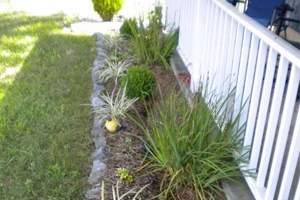 |
P. surinamensis is a burrowing cockroach, commonly burrowing in loose soil, humus, mould, compost piles and lawn thatch, or hiding beneath rocks, rotten branches, trash and other debris. It is considered peridomestic, found living only near human constructions or crops in a 1996 study, and may be considered synanthropic. It has a relatively high rate of cutaneous water loss compared to non-burrowing species of cockroaches, and is nearly exclusively associated with moist soil across its range. |
 |
Pest:
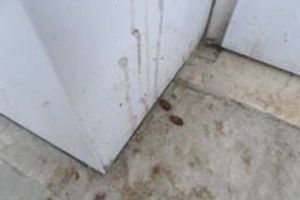 |
While the species is occasionally found inside homes, it is not a common household pest. It is a plantation and garden pest in tropical regions, and can be especially problematic in heated greenhouses, where large numbers can hide by day and emerge at night, gnawing the softer parts of plants. It is thought to be transferred into homes and businesses in potted plants or mulch used for potted plants. |
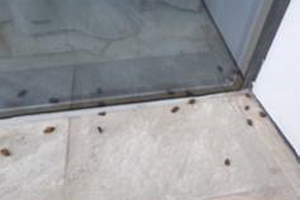 |
Parthenogenesis:
An unusual aspect of P. surinamensis is that the species reproduces parthenogenetically, a form of asexual reproduction in which embryos develop from unfertilized eggs. P. surinamensis reproduce by thelytokous parthenogenesis, a type of parthenogenesis in which offspring are almost exclusively female clones. Thelytokous parthenesis is known in about 1% of known animal species.
Optional thelkytokous parthenogenesis occurs in several cockroach species when females are isolated from males, including in the common domestic pests Blatta orientalis, Blattella germanica, and Periplaneta Americana, but in P. surinamensis it is obligatory parthenogenesis, its sole means of reproduction. Earlier taxonomy treated P. surinamensis as a species with both sexual and asexual forms, reproducing asexually in some populations, but sexually in other populations.
Obligatory parthenogenesis was known only in P. surinamensis until 2003, when it was reported in a form of the species Phyllodromica subaptera. Asexual forms of P. subaptera, spread through most Mediterranean countries.
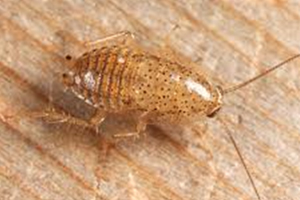 |
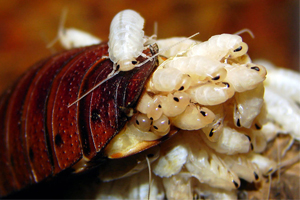 |
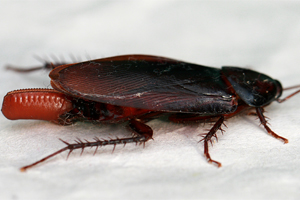 |
Parasite Host:
P. surinamensis acts as the intermediate host for the parasitic roundworms Oxyspirura mansoni and Oxyspirura parvorum, which infect the eyes of poultry.
O. mansoni, known as the chicken eye worm among other names, can cause eye problems ranging from mild conjunctivitis to severe ophthalmia and serious vision impairment in its final hosts, which include chickens, turkeys, guinea fowl and peafowl. Its life cycle involves eggs passing through a bird's lachrymal duct, being swallowed and passed in the bird's feces, a P. surinamensis cockroach eating the feces, larvae emerging in the cockroach, the bird eating the cockroach, and finally the eye worm larvae migrating up the oesophagus and pharynx to the bird's eye. While O. mansoni is not present in Europe, it is present in many areas of the world, particularly the tropical and subtropical environments where P. surinamensis is permanently established.
Control
Contact your pest management professional and request an inspection, to prepare a comprehensive pest management plan that will effectively and efficiently deal with the specific pest problem.

